Copyright 2020 - 2021 irantour.tours all right reserved
Designed by Behsazanhost
Sabzevar, Home to Sarbedaran popular Movement
Sabzevar, Home to Sarbedaran popular Movement
If you are going to find an all-in-one tourist destination in the northeast of Iran and close to Mashhad holy city, Sabzevar is the best one. This tourist city with a complex of historical, cultural, and artistic monuments is the best destination to discover Iran's history and culture.
Sabzevar is located about 250 kilometers west of the provincial capital of Mashhad in the northeastern Khorasan Razavi Province. Sabzevar is situated at an elevation of 974 meters above sea level and is the 2nd most populated city in Razavi Khorasan. Sabzevar, formerly called Beyhaq, gave rise to the 14th-century Sarbedaran movement, an uprising against the Mongol rulers of the land. The city was ruined and reconstructed many times throughout history until the Safavid era when it flourished. Sabzevar is the commercial center for an agricultural region producing grapes and raisins. There are some small-scale industries, for food processing, copperware, and electric motors. Through the old bazaar of Sabzevar, fresh, dried, and preserved fruits and vegetables are exported. The historian Abolfazl Beyhaqi (995-1077) is best known for his Beyhaqi History, which is considered one of the most credible sources on the Ghaznavid Empire (975-1187). The beautiful and fluent style of the book has made it a splendid piece of Persian literature.
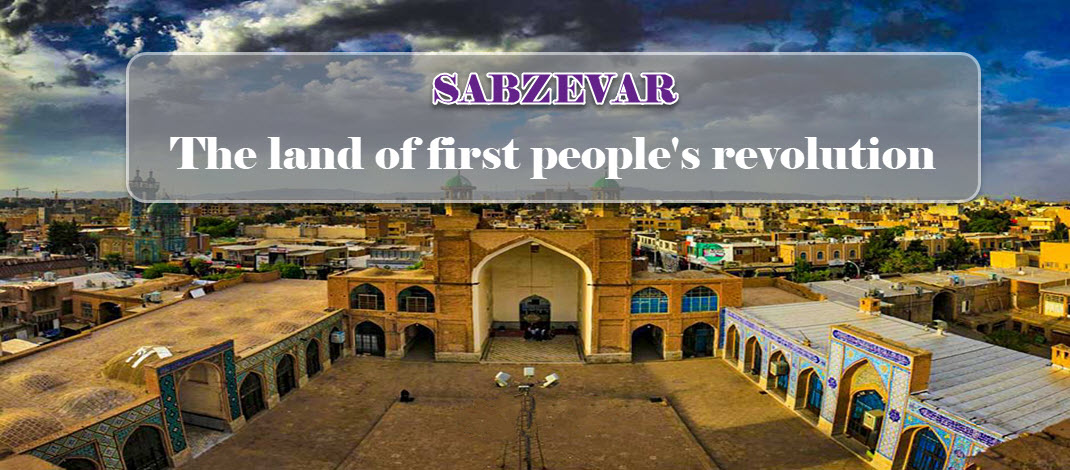 |
Geography of Sabzevar
Sabzevar as one of the major cities of Khorasan Razavi Province has a common border with South Khorasan province, Shomali Khorasan province, and Semnan Province. It is located between 940 and 977 meters above sea level and has temperate and dry weather.
Brief History
The historical monuments discovered in Sabzevar confirm the 12,000-year history. Archaeological studies in the southern parts confirm the signs of the Neolithic without pottery. The special location of this city in the vicinity of the Silk Road has caused the creation of many buildings throughout various eras, some of which are available from the Ilkhani period to the Qajar period. Sabzevar was one of the important cities of Parthian rule. It was also the residence of many philosophers and scholars during the rule of the Ilkhanids. In addition, the Shiite government of Sarbadaran, and the first popular uprising of the Sabzevar people against the Mongols began in this city. The Safavid kings made efforts in the development and expansion of this city, and during Shah Abbas, the Great, many charitable and public buildings such as caravanserais, reservoirs, mosques, and schools were established.
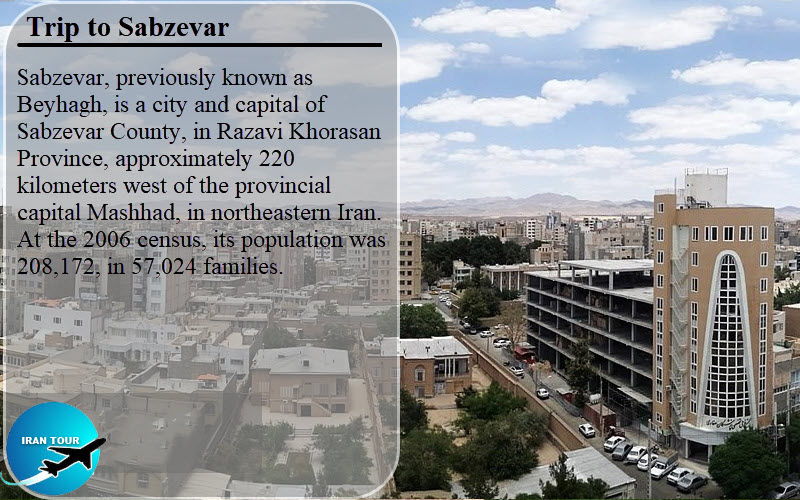 |
How to get there
Flight: There are scheduled flights from Tehran to Sabzwvar(five days a week). It takes about an hour's flight.
Train: Since this city is located in Razavi Khorasan province and is one of the important cities of this province, the train is one of the cheap, comfortable, and regular choices for traveling to this city (From 4 dollars).
Public Bus: Tehran bus terminals (East-West and Bayhaghi) have daily services to this city (From 4 dollars).
Private car: Traveling to Sabzevar via Imam Reza highway by private car is the fast option. It is located 660 kilometers northeast of Tehran and 235 km of Mashhad.
Sightseeings
The history of Sabzevar goes back to the 1st millennium BC. Ancient remains include the fire temple 'Azarbarzin' which is still visible.
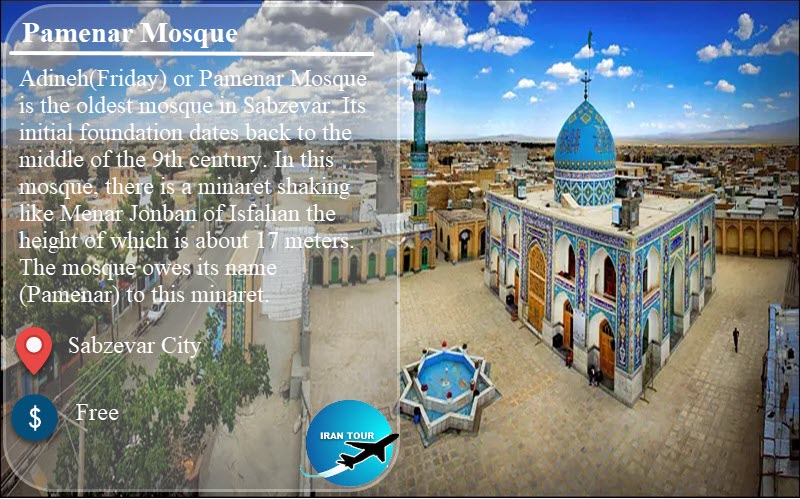 |
Pamenar Mosque
Archeologists have identified some 496 historical sites in Sabzevar scoping from ancient mosques, schools, and mausoleums to caravanserais, tombs, and prehistoric mounds. One of the oldest monuments in central Sabzevar is the 9th-century Pamenar Mosque which was constructed during the Taherid Dynasty - the first Iranian rule after the advent of Islam in the country.
The mosque stands next to a 15-meter-tall swinging minaret adorned with Kufic inscriptions and stunning brickwork. The minaret is over 900 years old and is attached to an Ivan.
Azure tiles bearing white Qur'anic verses adorn the Pamenar Mosque which includes a nine-arched sanctuary with three semi-arches. Pamnar Mosque is located in the city of Sabzevar and is the oldest mosque in this city and in Greater Khorasan. This mosque was built in 266 A.H. It was built during the time of the Abbasid caliph "Al-Mutamid Bellah" and during the reign of Muhammad bin Tahir, the last king of the "Tahirid dynasty(821 to 873)". This historical monument has been repaired several times in different periods. The modern building of the mosque with an area of approximately 350 square meters consists of a pillared nave and a courtyard on the south side, which is considered an annex to this mosque.
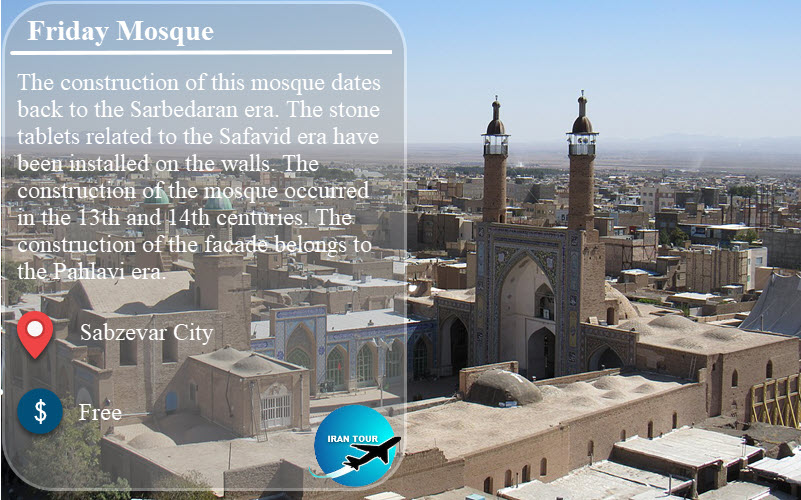 |
Jame Mosque
Another eye-catching structure in Sabzevar is the Jaame' Mosque which dates back to the 13th and 14th centuries. The mosque has two prayer niches (mihrabs), the first of which was built for Sunni Muslims, and the second, constructed inside the first, was designed for Shias. A Nast'aliq stone inscription has been placed above the entrance, which bears a decree from the Safavid king Tahmasb I. Two more inscriptions can be seen on the eastern walls bearing orders from Tahmasb II and the Qajar king Nasser al-din Shah. The mosque has two minarets, two Ivans, and two sanctuaries. Its facade is covered with multi-colored tiles covered with floral patterns and Qur'anic script.
Yahya Mausoleum
An obvious focal point in central Sabzevar is the Ilkhanid era Mausoleum located in the center of Sabzevar city. The 6th-century Yahya Mausoleum, built during the Ilkhanid era, has been renovated a number of times. The monument was decorated with green, azure, white, and golden tiles, bearing Qur'anic script in the 14th century. The building has two entrances and two minarets, which were later added to the original structure along with an Ivan, and a dome covered with colorful tiles forming the words Allah, Ali, and Mohammad. This great tiled work Mausoleum included a shrine, a large portico, with two minarets with a height of 29 m. , two chambers in the north and south of the shrine. The halls of the shrine are decorated with the best calligraphies in Tholth script can also be observed the theme of which are verses of the Holy Quran.
Demon House
The quadric arch is known by locals as the 'Demon House' and is believed by archeologists to be the remains of a fire temple belonging to Zoroastrian herdsmen and farmers. Located 2061 meters above sea level, the undecorated Sassanid stone structure, built in the form of a ziggurat, has a plaster-covered interior and exterior. Historical documents indicate that the Adur Burzen-Mihr temple is one of the three 'Royal Fires', believed by Zoroastrians to have existed since the beginning of creation.
Sabzevar the city of old Caravanseraies
Sabzevar with 16 old Carevanseraies has known to the city of Carevanseraies. Sabzevar is one of the cities of Iran, where different caravanserai have been built due to its location on the Silk Road and on the Tehran-Mashhad Pilgrimage Road and the number of travelers more than other regions of Iran. This city has 16 caravanserais inside and outside the city belonging to different eras. Among the various caravanserais, Faramarzkhan and Zaferanieh caravanserais are more famous.
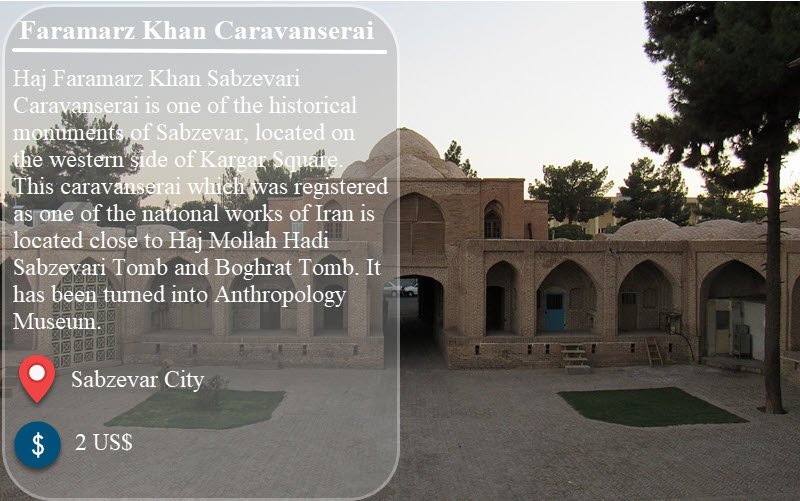 |
Faramarz Khan Caravanserai
Faramarz Khan Caravanserai has been turned into an anthropology museum, presenting a picturesque account of the city's traditions, customs and culture. As Sabzevar is located in an arid region with hot and dry weather, its ancient inhabitants created and used ice pits or Yakhchals as an early type of refrigerator. These dome-shaped structures had subterranean storage space for storing ice and food. The thick heat-resistant construction material insulated the storage space for the whole year.
Haj Faramarz Khan Sabzevari Caravanserai or Robat e Kanoon is one of the best old Caravanserai in Sabzevar that is repaired and changed into an anthropological museum to display the custom, art, and ceremonies of the Sabzevar people. The entrance gate is on two floors and decorated with the best Iranian geometric designs, ochre paintings, and original decorations. The materials used in this caravanserai include bricks, sand, plaster, lime, and wood.
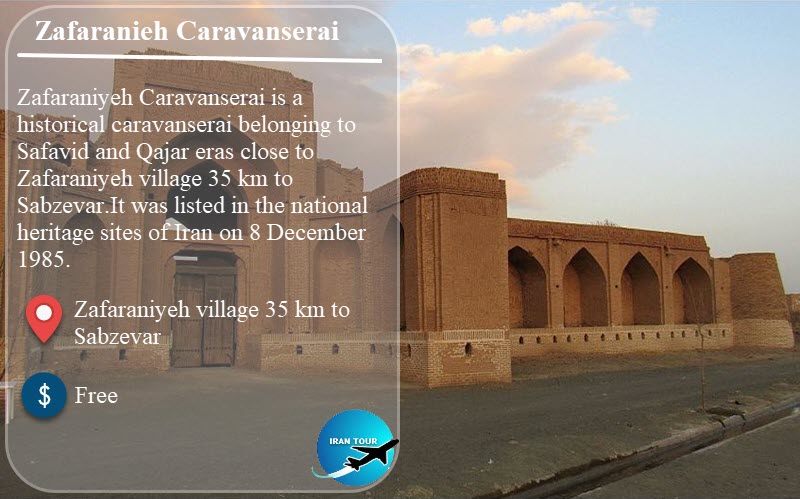 |
Zafaranieh Caravanserai
Abbasi Zafaranieh Caravanserai is an example of four porches Caravanserai. It is located in Zafaranieh village, 35 km from Sabzevar. Zafaranieh Caravanserai has a rectangular square plan and dimensions of 37 x 32.5 meters in the north-south direction and is built in the manner of four porches. The porches, cells, and large stables are built around a central courtyard. This caravanserai has seven observation towers. There are four round towers in the corners and one semi-circular tower on each of the northeast and west sides. Zafaranieh Caravanserai is one of the most historic caravansaries in Sabzevar city, which was built in the architectural style of the Seljuk period.
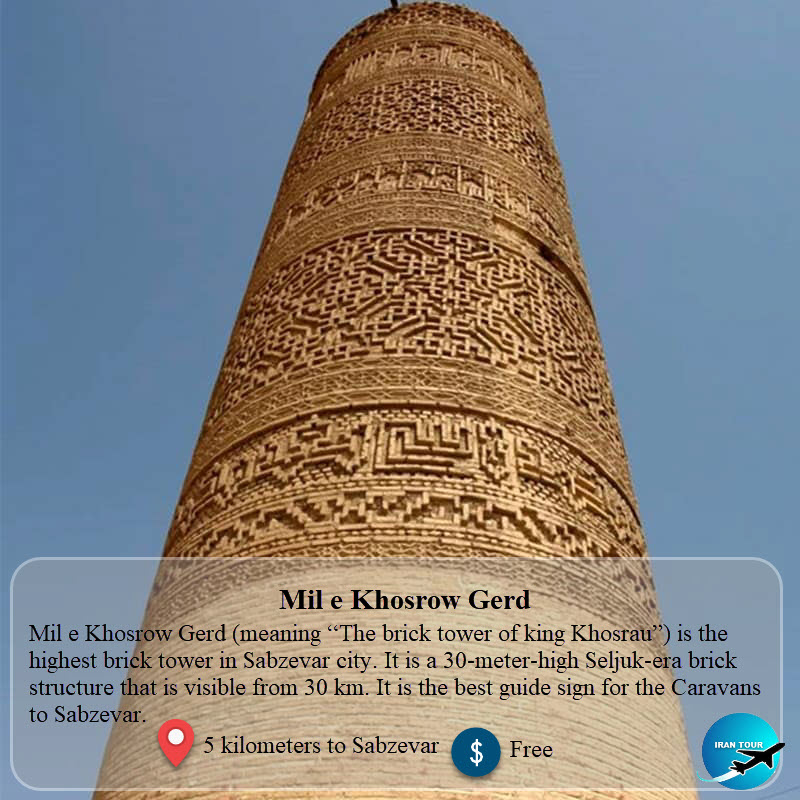 |
Mil e Khosrow Gerd
Mil e Khosrow Gerd (meaning "The brick tower of king Khosrow), located 5 kilometers to the west of Sabzevar is a 30-meter-high Seljuk-era brick structure and is the highest brick tower in the city. Decorated with Kufic inscriptions, the minaret is believed by some to have been part of a mosque. Some historians, however, say it was built to guide travelers, who could see it from 30 kilometers afar. Archeologists have unearthed earthenware and objects as old as 3-6 thousand years in Sabzevar's historical mounds. Located along the Silk Road, Sabzevar played host to dozens of travelers in its numerous roadside and city caravanserais, the remains of which still dazzle visitors with their elaborate chambers, stalls, and storage bays.
Molla Kamal Al-din Hossein Kashefi's Monument
Molla Kamal Al-din Hossein Kashefi (died in 910 LH) is among the famous scientists late of the Timurid period. He spent the main portion of his life in Herat City and died there. The present monument is built in memory of him by the national monuments society with engineer Ahmad Farahbakhsh's plan in 1352 AH. His monument is constructed on three floors and compounded of porches, four-porches, and sternum arches.
Historical glaciers
Historical Ice-houses are among the sights of Sabzevar, which is located in the southern part of the city. Sabzevar glaciers include 3 cone-shaped buildings made of clay and mud, which date back to the Qajar era. These buildings are built to store ice in the summer.
Sabzevar rugs
Sabzevar is on a major silk route between Mashad and Tehran. Due to the high copper content in the water, the wool found here is amongst the best Iran has to offer. Sabzevar has a rich history in rug design and has been an important source of Persian rugs since at least 1555. Sabzevar rugs are normally cotton based with a thin, tightly knotted wool pile. Similar to close-lying Mashad in design, but with a curvilinear pattern and rounded medallion, many of these rugs boast Sabzevar flower detail which has both blue and red flowers on its branches. The carpets are mid-to-large sized.
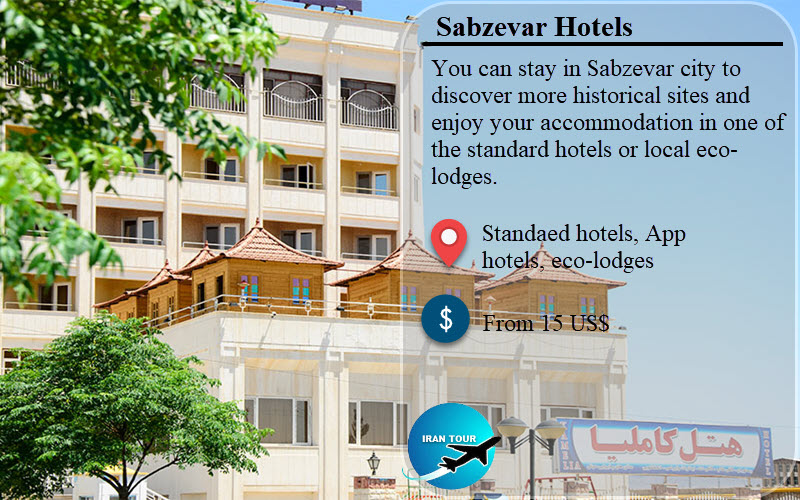 |
Where to stay
If you are interested to stay in this historic city, there are many options for you.
Camellia Hotel (3 stars ) and Tourist Hotel (2 stars) would be your best choices.
But if you are interested in getting to know the oriental lifestyle accommodation and the local people of Sabzevar, one of the local accommodations(eco-lodge) can be your best choice.
You can choose one of these accommodations easily (from 15 dollars per night).
- Details
- Category: Where to go in IRAN